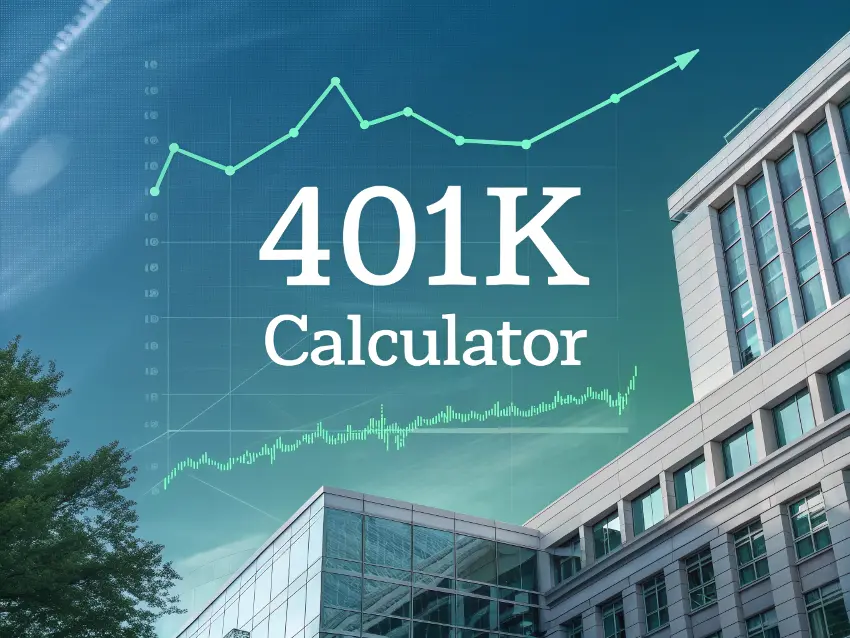401(k) Calculator
Plan your retirement with our 401(k) savings calculator

401(k) Retirement Plan
How 401(k) Plans Work:
A 401(k) is an employer-sponsored retirement plan that allows employees to save and invest a portion of their paycheck before taxes are taken out.
Tax Advantages: Contributions to traditional 401(k)s are tax-deferred, meaning you don't pay income tax on the contributions until you withdraw the money in retirement.
Employer Match: Many employers offer to match a portion of your contributions, which is essentially free money for your retirement.
Annual Contribution Limits (2023): $22,500 for individuals under 50, and an additional $7,500 "catch-up" contribution for those 50 and older.
Compound Growth:
FV = P(1 + r)^n + PMT × [(1 + r)^n - 1] / r
Where:
- FV = Future value of the account
- P = Present value (current balance)
- PMT = Periodic contribution
- r = Rate of return per period
- n = Number of periods
Inflation Consideration: While your 401(k) may grow significantly over time, inflation will reduce the purchasing power of your retirement savings. This calculator accounts for inflation to give you a more accurate picture of your future retirement income.
Note: This calculator provides estimates based on consistent contributions and returns. Actual results may vary due to market fluctuations, changes in contribution rates, or employer matching policies.
Calculate Your 401(k) Growth
Current Information
$
$
%
Annual contribution: $0.00 (capped at $0.00)
Employer Match
%
Example: 50% means your employer contributes $0.50 for each $1 you contribute, up to the limit
%
Example: 6% means your employer will match up to 6% of your salary
Future Projections
%
%
%
Your 401(k) Projection
Estimated Balance at Retirement:
$0.00
Inflation-adjusted value: $0.00
Years Until Retirement:
0
Retiring at age 65 in 2025
Estimated Monthly Income in Retirement:
$0.00
Based on the 4% rule (a common retirement withdrawal strategy)
Total Contributions:
$0.00
Your contributions: $0.00
Employer contributions: $0.00
Employer contributions: $0.00
Balance Growth Over Time
Growth Summary: Your initial balance of $25,000.00 will grow to $0.00 over 0 years. Of this amount, $0.00 comes from contributions, and $0.00 comes from investment earnings.
401(k) Strategies for Maximizing Your Retirement
Maximize Employer Match
At minimum, aim to contribute enough to get your full employer match. This is essentially free money and provides an immediate return on your investment.
Example: If your employer matches 50% of your contributions up to 6% of your salary, and you earn $60,000, you should contribute at least $3,600 (6%) to receive the full $1,800 employer match.
Increase Your Contributions Gradually
If you can't contribute a large percentage initially, start small and gradually increase your contribution rate over time. Consider bumping up your contribution percentage each time you receive a raise.
Tip: Many 401(k) plans offer an "auto-escalation" feature that automatically increases your contribution percentage annually. This makes saving more a painless process.
Consider Your Investment Allocation
Your investment allocation—how your money is divided among stocks, bonds, and other assets—is a crucial factor in your 401(k)'s growth. Younger investors can typically afford to be more aggressive with higher stock allocations.
Rule of thumb: A common starting point is to subtract your age from 110 or 120 to get your stock allocation percentage. For example, a 30-year-old might consider an 80-90% stock allocation.
Take Advantage of Catch-Up Contributions
If you're age 50 or older, you can make additional "catch-up" contributions beyond the standard annual limit. This is a powerful way to boost your retirement savings in your later working years.
2023 Catch-Up Amount: You can contribute an additional $7,500 for a total annual limit of $30,000 if you're 50 or older.
Understanding Fees and Expenses
Investment and administrative fees can significantly impact your 401(k) returns over time. Even a seemingly small difference in fees can result in a substantially lower balance at retirement.
| Fee Type | Description | Typical Range |
|---|---|---|
| Expense Ratio | Annual fee charged by investment funds in your 401(k) | 0.03% - 1.5% |
| Administrative Fees | Fees charged for plan administration and record-keeping | 0% - 0.5% or flat fee |
| Advisory Fees | Fees for investment advice or managed accounts | 0.2% - 1% additional |
Note: Lower-cost options like index funds typically have expense ratios of 0.03% - 0.2%, while actively managed funds might range from 0.5% - 1.5% or higher.